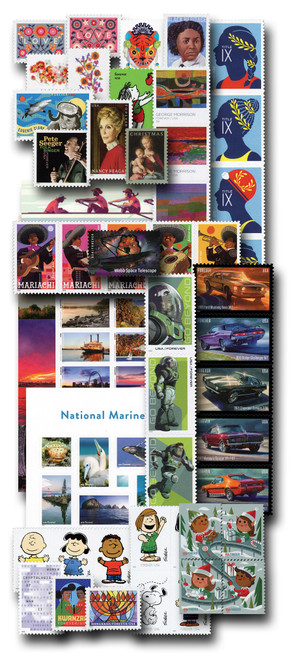
# 5695 - 2022 First-Class Forever Stamp - Women's Rowing: Red Team, 3 Oars, Splash in Water
US #5695
2022 Red Team Splash – Women’s Rowing
- Commemorates women’s rowing
Stamp Category: Commemorative
Set: Women’s Rowing
Value: 58¢ First Class Mail Rate (Forever)
First Day of Issue: May 13, 2022
First Day City: Philadelphia, Pennsylvania
Quantity Issued: 18,000,000
Printed by: Ashton Potter (USA) Ltd.
Printing Method: Offset
Format: Panes of 20
Tagging: Nonphosphored type III, block tag
Why the stamp was issued: To celebrate women’s rowing and its history.
About the stamp design: Includes two rowers dressed in red facing left. Artwork by Nancy Stahl.
First Day City: The First Day of Issue Ceremony was held at the Philadelphia Girls’ Rowing Club in Philadelphia, Pennsylvania.
About the Women’s Rowing set: Includes four different stamp designs on a pane of 20. The artwork covers the entire pane, picturing five, 8-person rowing teams on the water. The eight rowers face left, with a ninth person (the coxswain) in the selvage of each boat facing the opposite direction. The stamps picture artwork by Nancy Stahl.
History the stamp represents: Top athletes of every sport strive to obtain the best equipment possible to compete at the highest level. Rowing is no exception.
The two most important pieces of equipment for a rower are their boat and their oars. The boats used for rowing events are known as racing shells and they are produced with the goal of having the most lightweight, streamlined design possible. Early racing shells of the 1800s were produced by saturating pieces of paper with waterproof glue or varnish and layering them on top of each other. However, this method was expensive, especially when needing repairs. Designs transitioned to wood, with boats made from delicate spruce or cedar, then fiberglass, and finally carbon fiber or reinforced plastic (most common today).
Oar styles went through several designs, too. In the 1800s, oars were wooden, quite long, and had squared-off blade tips. This shape evolved in the 1960s to a shorter design with rounder blades (the Macon) made from composite materials. In 1992, the modern-day cleaver design was introduced. The asymmetrical blade shape allows for greater efficiency and faster, more powerful strokes. Many also have adjustable lengths.
It's always fun to discover how different equipment can make such a difference to an athlete. Who knows what design innovations we’ll see in the future?!
US #5695
2022 Red Team Splash – Women’s Rowing
- Commemorates women’s rowing
Stamp Category: Commemorative
Set: Women’s Rowing
Value: 58¢ First Class Mail Rate (Forever)
First Day of Issue: May 13, 2022
First Day City: Philadelphia, Pennsylvania
Quantity Issued: 18,000,000
Printed by: Ashton Potter (USA) Ltd.
Printing Method: Offset
Format: Panes of 20
Tagging: Nonphosphored type III, block tag
Why the stamp was issued: To celebrate women’s rowing and its history.
About the stamp design: Includes two rowers dressed in red facing left. Artwork by Nancy Stahl.
First Day City: The First Day of Issue Ceremony was held at the Philadelphia Girls’ Rowing Club in Philadelphia, Pennsylvania.
About the Women’s Rowing set: Includes four different stamp designs on a pane of 20. The artwork covers the entire pane, picturing five, 8-person rowing teams on the water. The eight rowers face left, with a ninth person (the coxswain) in the selvage of each boat facing the opposite direction. The stamps picture artwork by Nancy Stahl.
History the stamp represents: Top athletes of every sport strive to obtain the best equipment possible to compete at the highest level. Rowing is no exception.
The two most important pieces of equipment for a rower are their boat and their oars. The boats used for rowing events are known as racing shells and they are produced with the goal of having the most lightweight, streamlined design possible. Early racing shells of the 1800s were produced by saturating pieces of paper with waterproof glue or varnish and layering them on top of each other. However, this method was expensive, especially when needing repairs. Designs transitioned to wood, with boats made from delicate spruce or cedar, then fiberglass, and finally carbon fiber or reinforced plastic (most common today).
Oar styles went through several designs, too. In the 1800s, oars were wooden, quite long, and had squared-off blade tips. This shape evolved in the 1960s to a shorter design with rounder blades (the Macon) made from composite materials. In 1992, the modern-day cleaver design was introduced. The asymmetrical blade shape allows for greater efficiency and faster, more powerful strokes. Many also have adjustable lengths.
It's always fun to discover how different equipment can make such a difference to an athlete. Who knows what design innovations we’ll see in the future?!







